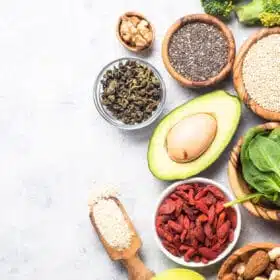Anyone who wants to eat healthy or lose weight is faced today with an almost unmanageable number of diets and nutrition plans. Most of these models are merely trends and lack any empirical basis. The Paleo or Stone Age Diet Diet is based on current research results in the fields of evolution and medicine. This form of diet consists of a proven concept that has as its goal an ideal body weight in combination with optimal health and maximum performance.
What is allowed?
The Paleo diet allows only foods that our Stone Age ancestors also fed on. According to the Paleo diet, our body and digestive system has not been able to adapt to the new foods of cereals and dairy products until today, because our genes have not changed since the Stone Age. Our intestinal tract is still designed to healthily consume only the same foods that our Paleolithic ancestors ate from about 2.6 million years ago. Therefore, only foods such as pasture-raised meats, wild-caught fish, seafood, vegetables, certain fruits and nuts are allowed.
What is not allowed
At the Paleo diet is carefully observed that certain foods must not be eaten. Below we have listed the individual specifications of the Paleo diet explained in detail.
Rule 1: No sugar
Sugar and sugary drinks such as fruit juices, iced tea, soft drinks or soft drinks are to be absolutely avoided. Sugar causes blood sugar and insulin levels to rise very quickly. Insulin is a so-called storage hormone that ensures that energy can be stored and released. A permanently elevated insulin level can cause diseases such as insulin resistance, diabetes or persistent high blood pressure.
Rule 2: No grain
Cereal products and especially white flour are among the forbidden foods in the Paleo Diet. Corn and rice should also be avoided, as these carbohydrate-containing products are also allegedly not beneficial to health. Cereal products contain almost up to 80 percent carbohydrates, which can lead to a sustained increase in blood sugar levels. In addition, cereals contain the ingredients gluten, lectin and phytic acid, which can damage the intestinal walls of the gut. This then results in the absorption ability of other important nutrients being impaired and then no longer being available to the body for energy production. This obstruction of individual nutrients can cause autoimmune diseases such as allergies or even multiple sclerosis. The intestines lose their defenses, which can lead to the development of what are known as leaky gut or oozing intestine syndromes. Lectins can also cause significant health conditions such as arthritis, Crohn's disease, or even irritable stomach. The pancreas can also be significantly stressed, which can then lead to type-1 diabetes. Grain is a product that has only been consumed by humans for about 10,000 years since the beginning of agriculture. This period has according to Paleo diet was not enough for the human digestive tract to get used to grain products.
Rule 3: No vegetable fat
Also the nutrient fat is used in the Paleo diet strongly considered. Vegetable fats such as safflower, sunflower or rapeseed oil as well as margarine should be avoided because they contain large amounts of unsaturated fat and trans fatty acids. Trans fatty acids cause inflammation in the body, increase the risk of heart disease and promote the storage of body fat. Only olive and coconut oil are allowed. Coconut oil is the only vegetable fat that contains saturated fatty acids. Butter and lard, on the other hand, may be eaten because they contain important fatty acids.
Rule 4: No ready meals
Prepared meals and fast food products are the most important Paleo diet absolutely taboo, because they contain ingredients harmful to the body, such as sugar, chemical additives and unsaturated fatty acids. Particularly harmful to the body are hidden additives such as glutamate, flavor enhancers, preservatives, stabilizers and artificial flavors. Although these substances comply with legal requirements, to date there are no empirical results on the long-term effects of these ingredients. The only known effect is that of glutamate, which stimulates the appetite and can therefore also lead to excessive food intake.
Rule 5: Only certain types of fruit
Fruit is healthy, tastes refreshing and delicious, and also contains many valuable nutrients and vitamins. But certain types of fruit also contain a lot of sugar in the form of fructose, which should be absolutely avoided according to Rule 1. Half an apple contains the dose of a heaped teaspoon of table sugar. It is therefore better to eat more berries, such as blueberries or strawberries. According to the Paleo diet fruit was taken by humans in the Stone Age rather in small quantities, because many varieties of fruit were planted or grown later. Also, the popular canned fruits contain a lot of sugar, so they should also be avoided.
Rule 6: No dairy products
Milk and all dairy products are also to be avoided in the Paleo diet should be avoided, because these products can also cause certain autoimmune diseases. Milk, like cereals, has also only been considered as a food source by humans for around 10,000 years. Especially cow's milk is not tolerated by many people, which can then lead to lactose intolerance. It has also been proven that certain animal hormones in milk can lead to increased storage of body fat, regardless of how the animals are kept. If the cows are fed grain, the harmful lectin can also enter the milk again.
Conclusion
The diet of our ancestors certainly varied according to location and season, as these components had significant influence on the diet of a Stone Age man. The theory of the Paleo diet is based on the food sources vegetables, caught game and fish, collected nuts, seeds and mushrooms and certain fruits that were available in the wild. The main nutrients in the Paleo diet are proteins and fat, while carbohydrates were included as fiber in the form of fruit and honey. The food pyramid of a Paleo diet consists of 15 to 20 percent protein, 20 percent carbohydrates and about 60 percent from fat.




